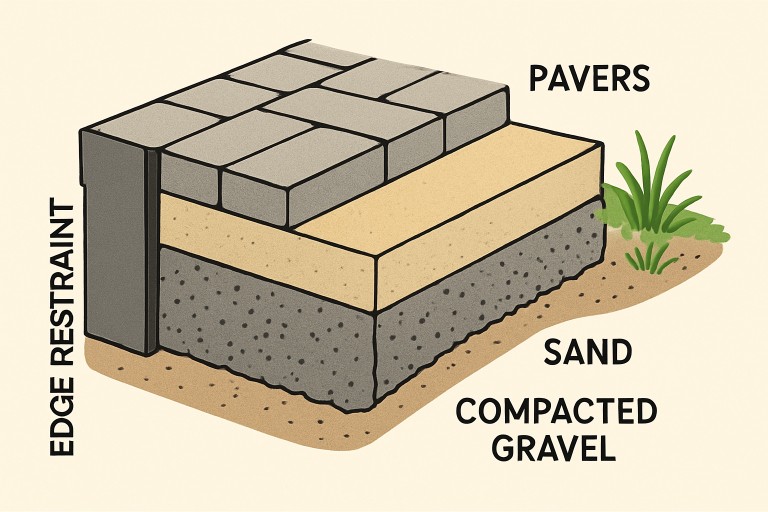Creating durable and visually appealing paver surfaces requires thoughtful planning and consistent maintenance, both of which play a vital role in their longevity and curb appeal. Issues such as shifting, staining, and weed growth can shorten the lifespan of your pavers, but proactive care helps preserve their structure and beauty. This guide provides a detailed approach to proper preparation, installation, and maintenance, emphasizing the importance of selecting the right paver materials for their intended use, recognizing early signs of wear, and employing techniques such as edge restraints and high-quality joint materials to minimize damage.
For added protection and enhanced aesthetics, consider paver sealing Port St Lucie, which helps lock in color, resist stains, and extend the life of your outdoor surfaces. By following these best practices, you can ensure that your paver investment remains both functional and aesthetically pleasing for years to come.
Additionally, regular cleaning and timely repairs can prevent minor imperfections from developing into significant structural problems. Incorporating proper drainage solutions also helps protect the foundation from water damage and erosion. With consistent attention and the proper maintenance strategies, your paver surfaces can maintain their original charm and durability through every season.
Proper Base Preparation
The foundation of long-lasting paver surfaces always starts with expert base preparation. Neglecting the base layers often leads to costly problems, such as sinking, shifting, and uneven surfaces. To build a resilient paver area:
- Excavate the area at least 9-12 inches below the final surface grade for optimal stability.
- Spread and firmly compact 4-8 inches of crushed stone or gravel to ensure a level and supportive base.
- Use a mechanical compactor between each layer to prevent future settling and enhance drainage capabilities.
Choosing the Right Pavers
Paver thickness and material type should reflect the intended use of the area:
- Patios and walkways can use pavers ranging from 40 to 60 mm thick, which are suitable for foot traffic.
- Driveways and areas for vehicles must use thicker pavers (60-80 mm) to withstand greater loads and prevent cracking.
Using undersized or poorly suited pavers sets the stage for rapid wear and potential failure, significantly reducing the lifespan of your investment.
Installation Best Practices
Attention to detail during installation guarantees both safety and longevity. Make sure to:
- Add strong edge restraints to lock your paver pattern in place and stop lateral creep.
- Maintain consistent spacing between pavers and fill joints with quality sand or polymeric sand for bulletproof interlock and reduced weed invasion.
- Follow the latest manufacturer and industry installation standards for your specific paver type to avoid common and costly mistakes.
Regular Cleaning and Maintenance
Preventative care keeps pavers looking their best and wards off larger problems:
- Sweep surfaces regularly to eliminate grit and debris that cause discoloration and spark weed growth.
- Clean accidental spills the moment they occur to stop stains from setting.
- When using a pressure washer, opt for a gentle setting and a fan tip to prevent erosion of the paver surface or loss of joint material.
Sealing for Enhanced Durability
Sealing is a powerful way to protect and enhance both new and old pavers. A quality sealer:
- Keeps colors bright by shielding from harmful UV rays.
- Acts as a barrier against oil, grease, and other stubborn stains.
- Discourages weeds from sprouting and insects from burrowing in the joints.
Most experts recommend resealing paver surfaces every 3-5 years, depending on local climate and frequency of use. For additional information on sealing methods and products, refer to the Homes & Gardens guide on cleaning patio pavers.
Regular sealing not only extends the lifespan of your pavers but also helps maintain a polished, well-kept appearance year-round. It minimizes surface erosion caused by rain and foot traffic, preserving the pavers’ structure and texture. Investing in professional sealing or using high-quality DIY products ensures lasting protection and easier maintenance in the long run.
Addressing Common Issues
Even well-cared-for pavers can encounter issues over time. Tackle these early with targeted solutions:
- Weed Growth:Pull or treat weeds at the first sign, and use polymeric sand to fill joints to prevent future outbreaks.
- Staining:Quick action and the use of appropriate cleaning agents help prevent stains from becoming permanent. Always check the compatibility of the cleaner with your paver material first.
- Settling or Shifting:If you notice dips or movement, evaluate the base for compaction flaws and make necessary corrections before re-installing troubled pavers.
Seasonal Care Tips
Adapting your paver maintenance routine for each season increases resilience:
- Winter:Use plastic or rubber-edged shovels when clearing snow, and avoid harsh deicing salts that can break down paver surfaces.
- Spring:Inspect pavers for frost heave, cracks, or loose edges caused by winter weather and address any necessary repairs immediately.
- Summer:Perform a deep clean and reseal if UV exposure or heavy use has dulled the surface or worn away the protection.
- Fall:Rake leaves and debris quickly to prevent tannin stains and reduce moisture retention that leads to erosion and mold growth.
Conclusion
Consistent attention and innovative maintenance practices ensure the lasting beauty and functionality of any paved surface. Committing to thorough base preparation, selecting the right paver types, adhering to best installation methods, maintaining your paver areas regularly, and sealing them regularly will help your paver areas thrive for decades.

